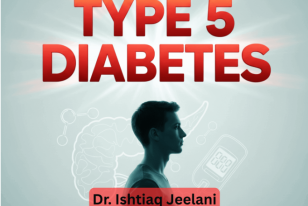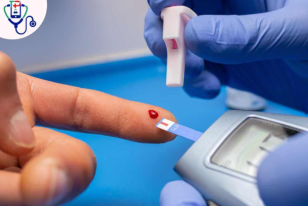Understanding Type 5 Diabetes: A Guide to this newly recognized form
- 15 Oct 2025
- 0 Comments
- Diabetic Health
By: Dr. Ishtiaq Jeelani
Diabetes affects so many lives, but not all forms fit the usual patterns of Type 1 or Type 2. Today, we are focusing on Type 5 diabetes, a condition that primarily impacts lean individuals with a history of undernutrition. This comes from a recent international consensus statement published in The Lancet Global Health, which draws on decades of research to highlight this overlooked type. Our goal is to explain it clearly, using only details from that statement and verified studies, so you can recognize the signs and understand next steps. If you or someone you know has faced high blood sugar without the typical risk factors, this might resonate.
History: From early observations to official recognition
Diabetes is a growing concern worldwide, especially in low income and middle income countries where both undernutrition and overnutrition create unique challenges. While obesity and aging fuel most Type 2 cases, undernutrition plays a role in other forms, particularly among young lean adults with body mass index below eighteen point five kilograms per square meter and age under thirty years, (under 30, BMI <18.5) who have faced poor nutrition from before birth through childhood.
This pattern was first described in 1955 by P Hugh Jones in The Lancet, based on his work in Jamaica. He observed young underweight people with what seemed like insulin resistant diabetes but without the tendency for ketoacidosis, calling it J type diabetes after Jamaica. Early reports suggested these patients needed large insulin doses, but deeper studies showed normal insulin sensitivity with severe insulin secretion issues. In 1985, the World Health Organization recognized it as malnutrition related diabetes, a separate category. However, in 1999, they removed it due to debates over whether undernutrition alone caused it. Despite this, reports from countries including India, Pakistan, Bangladesh, Uganda, Ethiopia, Rwanda, Nigeria, and Indonesia continued to document this lean diabetes linked to low socioeconomic status and prolonged undernutrition. The International Classification of Diseases tenth revision code E12 point nine and eleventh revision code E12 point eleven still include it.
The consensus (and IDF summaries) estimate roughly 20–25 million people worldwide may have this phenotype, mainly in low income and middle income countries. A 2024 study on twenty years of trends in lean diabetes among South Korean adults found a similar rise to Type 2 diabetes. Yet, without clear agreement on naming and limited World Health Organization support, it has gotten less attention, leading to poor identification and research gaps. This results in overlaps with other types like fibrocalculous pancreatic diabetes or antibody negative Type 1, especially in resource limited areas, and no studies on treatment responses to insulin or oral agents.
On January 8 and 9, 2025, thirty nine experts met in Vellore, India, to review evidence. They included researchers from low income and middle income countries, global diabetes leaders, and specialists. Discussions covered literature reviews, differential diagnoses excluding other low body mass index diabetes forms, and research needs. They unanimously agreed on a distinct non autoimmune classification, the Vellore Declaration. Recognizing Types 3 and 4 for other conditions, they proposed Type 5 diabetes, announced by the International Diabetes Federation at their World Diabetes Congress in April 2025. President Peter Schwarz launched the Type 5 Diabetes Working Group to create diagnostic and treatment guidelines.
Key Features: What sets Type 5 Diabetes apart
Over seven decades, this phenotype has appeared worldwide, often in underweight people from low resource settings. Studies using advanced tools like clamps and tracers, after ruling out other diabetes types, show impaired insulin secretion, low C peptide, and normal sensitivity, unlike Type 2. Insulin levels are higher than in Type 1, and ketoacidosis is rare. Diagnosis often occurs in the third decade, with early life undernutrition persisting into adulthood. Autoantibodies like those against GAD 65 and IA 2 are absent. Pancreatic imaging shows no calcifications, ductal hypoplasia, or dilatation, unlike fibrocalculous pancreatic diabetes. Body composition reveals low total and trunk fat, especially liver lipids. Most cases link to low socioeconomic rural areas with poor protein and calorie intake.
Here are the features from the consensus:
Commonly reported features
- Body mass index less than (<18.5) eighteen point five kilograms per square meter for adults
- Moderate to severe hyperglycemia
- Low C peptide concentrations in the fasting or random state, or low serum insulin
- Ketosis resistance
- Negative for clinical signs of insulin resistance for example acanthosis nigricans
- Negative for GAD 65 antibody and IA 2 and ZnT eight antibodies if available
Occasionally reported features
- History of early life undernutrition as evidenced by one or more of the following
- History of low birthweight
- History of undernutrition in infancy
- History of stunting in childhood
- A history of undernutrition in early life intrauterine infancy childhood and adolescence as shown by
- Weight for height less than minus three standard deviations for severe acute malnutrition in children younger than five years
- Body mass index less than minus three standard deviations for age five to nineteen years
- Normal pancreas on comprehensive pancreatic imaging ultrasonography or preferably computed tomography
- Low total body fat percentage on either dual energy absorptiometry or bioimpedance analysis
- Negative monogenic beta cell studies for genetic variants
- Low socioeconomic status
- Rural origin
Although not all features appear in every case, they help distinguish Type 5 from Type 1, uncontrolled Type 2 with weight loss, pancreatic disorders like fibrocalculous, maturity onset diabetes of the young, lipodystrophic disorders, and ketosis prone diabetes. More research is needed for exact body mass index cutoffs tied to undernutrition.
Pathophysiology: How undernutrition shapes this form
The full mechanisms remain unclear, but intrauterine undernutrition followed by ongoing childhood and adolescent shortfalls likely raise risk. Low birthweight babies exposed to normal or high calorie diets post birth often catch up grow, leading to overgrowth, fat buildup, insulin resistance, and beta cell liver expansion, risking classic Type 2 diabetes.
In contrast, lean undernutrition linked diabetes involves continued undernutrition into adulthood, causing beta cells to produce insufficient insulin. The consensus and related mechanistic work suggest chronic early-life undernutrition may cause oxidative stress and antioxidant depletion, which can impair beta-cell function and insulin secretion, animal and laboratory studies point to disrupted beta-cell transcriptional regulation (for example PDX1/MafA pathways), but these mechanisms in humans remain hypotheses requiring further study. Excess reactive oxygen species speed beta cell death, reducing mass and output. Body analysis shows much lower fat than Type 2, with normal sensitivity. Since not all undernourished develop diabetes, genetics or epigenetic beta cell changes may contribute. The process is multifactorial.
Ethical limits prevent human undernutrition trials, but animal models, famine cohort studies, and observations link undernutrition to Type 5 features, supporting its distinct status.
The life course figure shows two paths under different conditions: Preconception early gestation mid gestation late gestation infancy and childhood adulthood. Early life undernutrition with persistent life course undernutrition leads to Type 5 diabetes via ongoing undernutrition and pancreatic beta cell underperformance. Early life undernutrition with subsequent overnutrition leads to classic Type 2 diabetes via rapid transition overnutrition obesity insulin resistance.
Management: Practical approaches for better outcomes
With limited data, management relies on clinical experience, not trials. Weight loss advice for overweight Type 2 patients does not fit here and could harm undernourished lean individuals with low muscle. Traditional Type 2 drugs like metformin cause weight loss, and insulin roles need confirmation. Insulin is hard in low resource areas due to cost and access, and misuse risks hypoglycemia amid food insecurity without monitoring.
Type 5 patients may need only minimal insulin or secretion stimulants to control sugar and avoid lows. Sulfonylureas help but require caution. Dipeptidyl peptidase four inhibitors are safe but may lack power for severe deficiency. Glucagon like peptide 1 agonists unlikely suit due to weight loss and sarcopenia risks. Metformin works empirically in low body mass index cases despite not aiding secretion, though no literature confirms efficacy there. Sodium glucose cotransporter 2 inhibitors may work independently of deficiency or resistance, but calorie weight loss harms this group. Overall, treatments are trial based, needing nutrition and therapy studies.
Beyond drugs, address nutrition gaps. Rehabilitation and education promote balanced protein energy and micronutrient diets for lasting care. For low socioeconomic patients, use local culturally fit cost effective options like energy dense staples high in protein and complex carbohydrates such as lentils legumes oil enriched cereals and fortified grains, plus family community worker training. Integrated with public programs like midday meals maternal child nutrition or conditional cash transfers. Community undernutrition management with ready to use therapeutic foods or home fortified foods aids severe cases.
Guidelines must cover psychosocial cultural and educational hurdles. Atypical features need community education on presentation diagnosis and nutrition pharmacology to boost adherence. Future work should blend education psychosocial support for better results.
Prevention: Steps toward a healthier future
To curb Type 5s global load, nations must hit Sustainable Development Goals, 1) end poverty everywhere and 2) end hunger, achieve food security, improve nutrition, promote sustainable agriculture. Agencies can increase simple low cost nutritious protein rich foods especially for women of childbearing age infants and children including ideal breastfeeding; run poverty programs like job training employment food banks and cash transfers; screen for undernutrition refer to care with nutrition interventions and raise awareness of Type 5 features and management among providers and policymakers. Strategies require further research and data.






Comments (0)